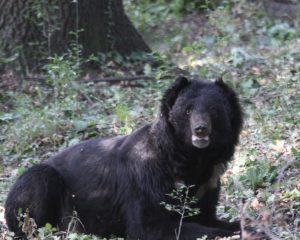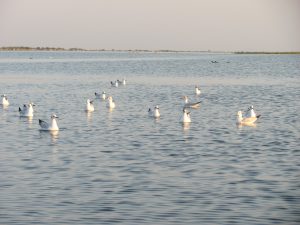Climatic variations and warmer winters have changed the habits of Asian black bears and migratory birds in recent years in the Himalayan state of Jammu and Kashmir in northern India, say wildlife experts. This has led to an increase in the number of bear attacks and human-bear conflicts in the Himalayas.
“We have been witnessing a considerable decrease in the hibernation period of the Asian Black bear over the past several years,” regional wildlife warden for Kashmir, Shuja Hyderi, told thethirdpole.net.
This, he said, is happening because of less winter snow and temperatures rising earlier than expected– in late January or early February – over the past few years.
How many bear attacks occur?
Asian black bear’s lack of hibernation has increased the incidence of bear attacks and human-animal conflicts in Kashmir during the winter, say officials.
“The direct fallout of this reduction in hibernation of the Asian black bear is a sharp increase in the incidents of human-animal conflicts, as the animal now remains active almost throughout the year,” Hyderi said.
In 2008-9, 25 people were killed and 342 injured by bears in Kashmir. By 2011-12 this number reached 40 and 562 respectively, according to wildlife department figures.
Before the 1990s, black bears used to hibernate from November to March, “but now its biological setup has been completely disturbed with the animal hardly hibernating at all.”
Senior wildlife scientist at the Centre for Mountain Wildlife Sciences at the Sher-e-Kashmir University of Agricultural Sciences and Technology (SKUAST), Khursheed Ahmad agrees: “If there is a less harsh winter, bears prefer to roam around in the woods and nearby human habitations in search of food,” Ahmad told thethirdpole.net.
Climate change is not the only reason, he argues. The massive expansion of orchards in the region has provided a source of food for bears. Kashmir’s orchards have almost doubled in size from 70,364 hectares in 1990s to 127,759 hectares today, as farmers have shifted from paddy to apple cultivation. Apples provide enough sustenance to keep black bears active during the winter, the scientist explained.
Asian black bears, also known as moon bears, are listed as “vulnerable” species by the ICUN because of loss of habitat and widespread hunting for their body parts, particularly in China and South-East Asia.
But the bears are found in good numbers in Kashmir. “It has been estimated that Kashmir has the highest density of black bears especially in and around the Dachigam National Park,” Ahmad said. Despite a ban on killing wild animals, unofficial reports suggest that at least 10 black bears are killed on average every year as the wild animals descend on villages and kill and injure people.
The growing incidents have led the state government to increase the amount of compensation for those getting killed and maimed by the wild animal from 100,000 rupees ($1,700) to 300,000 rupees ($5,100).

Changing climate boon for migratory birds
The warmer weather has brought some welcome changes as well. Migratory birds are staying longer on the famous Dal Lake.
“We have noticed that mild freezing or absolutely no freezing in the Dal Lake and other lakes has encouraged water-fowls to stay right through the winter more frequently now,” Hyderi said.
“From the tourism point of view, this is quite a boon as the birds add to the beauty of the lake which fascinates tourists, especially bird-watchers,” Hyderi said.

But Hokersar wetland – known as the queen of wetlands because of the variety and number of winged visitors it receives – has seen fewer birds this year because of the damage caused by the devastating 2014 floods. Large expanses of the wetland have been lost to rapid urban development as well in recent years.
“Hokarsar used to get around 800,000 birds a year, but this number has fallen considerably this year,” said Ahmad.
Only 460,000 birds visited Hokarsar in 2014, according to the first ever survey of the state’s 13 wetlands carried out by the wildlife department in early February this year. Hokarsar receives 80% of birds in Kashmir, according to the survey. “From now on, we will repeat this survey every year,” the regional wildlife warden said.

